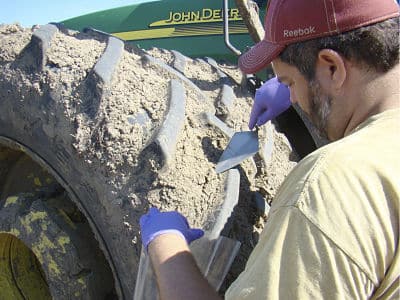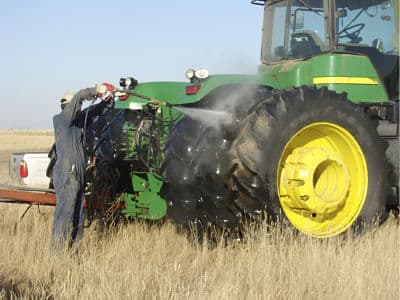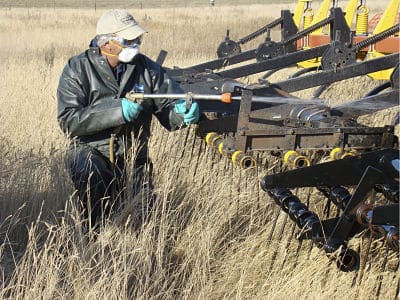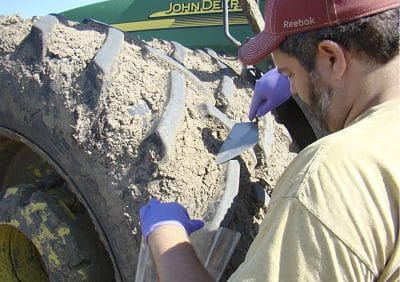The most common way to transfer soil from field to field is on farm machinery and vehicle tires. The CCC has a new guide with tips to clean equipment and prevent clubroot’s spread. Click here for the full guide. The following article is a short summary of the guide. Visit www.clubroot.ca for general information on clubroot.
Assess your risk
The following questions will help determine the risk of clubroot spread to your farm, or from field to field within your farm. Your answers will help you decide how much sanitation you need and when to use it.
—Do you already have clubroot in at least one field? If yes, thorough sanitation between each field may be warranted.
—Have you purchased used equipment that may have originated in clubroot infested areas? If the equipment originates from a clubroot-infested area, make sure the equipment is sanitized before it comes to your farm.
—Has your equipment been used in fields in clubroot-infested areas? If so, it should be cleaned and disinfected before it comes back to your farm.
—Who has access to your land? Custom sprayers and seeders, oil and gas equipment and trucks, earth-moving and excavating machines, soil sampling trucks, fertilizer trucks, hunters, recreational vehicles and even agronomists can carry clubroot-infested soil on tires, machinery and shoes. Make sure they follow clubroot risk mitigation protocols.
—Do you use tillage? Tillage or any other farm practice that involves soil disturbance or results in frequent travel throughout a field will increase the risk of transporting clubroot-infested soil.
3 steps for equipment sanitation
Choosing a worksite. You should clean and disinfect the unit before leaving the field, and leave all contaminated soil in that field. A low-traffic grassed area near the field exit is an ideal place to sanitize equipment .

Step 1: Rough cleaning. Use a hand scraper, wire brush or compressed air to remove loose and clinging soil and crop debris from openers, tires and wheels, and the frame. This should remove at least 90% of the soil from the unit. Time required: 1-2 hours for a 40 foot cultivator. Larger pieces of equipment, tractors and double disk units may take longer.

Step 2: Fine cleaning. Use a pressure washer at 2,000 to 3,000 psi on all areas where soil can accumulate. Turbo nozzles are generally more effective at removing soil than regular nozzles. An industrial detergent may enhance the degree of soil removal. Steps 1 and 2 in combination should remove 99% of soil from the unit. Time required: 1-2 hours for a 40 foot cultivator. (2-4 hours total for steps 1 and 2.)

Step 3: Disinfection. Disinfect all openers, tires and wheels with a 1% bleach solution or surface disinfectant of equivalent strength. A 3-gallon backpack herbicide sprayer will work for this job. All areas should remain wet with the solution for 15 to 20 minutes. Step 3 alone is not effective. The first two steps are required if you plan to include the disinfection step. Time required: 2 hours or more. (Four hours or more for steps 1, 2 and 3.)
Recommendations for high risk areas
For growers in an area known to have clubroot, the following steps are recommended to reduce the risk of clubroot spread:
—Follow cleaning steps 1-3, or at least 1-2, above. This is especially important when leaving a field known to have clubroot. The more soil you clean from the unit and leave behind in the field, the more you reduce the risk of clubroot being spread.
—Work infested fields last. This reduces the risk of directly transferring contaminated soil from infested to non-infested fields and should have extra time to give drills and tillage equipment a thorough cleaning before being used again.
—Don’t work fields when wet. Wheels caked in mud are that much harder to clean.
—Ensure custom operators and anyone else entering your fields follow sanitation protocols. Don’t feel awkward about asking.
—Be responsible. Growers should tell local authorities and custom operators that clubroot has been discovered in their field. Some municipalities require this by law. In other areas, this is just a common courtesy. Consider posting “Do not enter” signs beside fields known to have clubroot.
Recommendations for low risk areas
For growers in areas where clubroot is not found:
—If in doubt, decontaminate. If using your own equipment and you know clubroot is not on your farm, decontamination may not be required.
—Ask custom operators, oil and gas company surveyors and anyone else entering your fields where they’ve been. Some of them cover wide geographic areas. If they have been in a clubroot-infested area, ask about their sanitation protocols and check that the machinery is clean.
—Make sure used equipment is clean. When buying used equipment, make sure it’s clean before it leaves the auction site or the farm it comes from. Also check that the transport truck is clean. As a precaution, you may want to pressure wash the equipment again when it gets to your farm.

